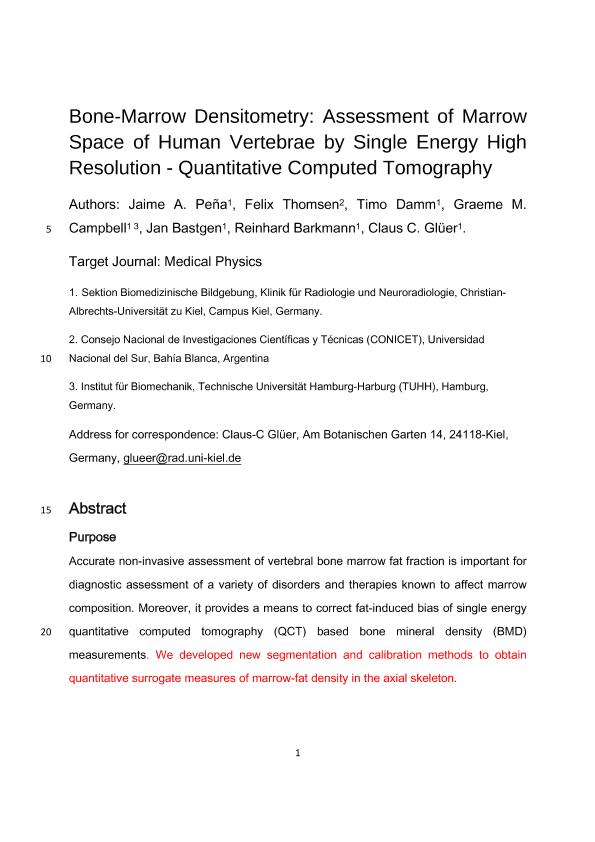Artículo
Bone-marrow densitometry: Assessment of marrow space of human vertebrae by single energy high resolution-quantitative computed tomography
Peña, Jaime A.; Thomsen, Felix Sebastian Leo ; Damm, Timo; Campbell, Graeme M.; Bastgen, Jan; Barkmann, Reinhard; Glüer, Claus C.
; Damm, Timo; Campbell, Graeme M.; Bastgen, Jan; Barkmann, Reinhard; Glüer, Claus C.
 ; Damm, Timo; Campbell, Graeme M.; Bastgen, Jan; Barkmann, Reinhard; Glüer, Claus C.
; Damm, Timo; Campbell, Graeme M.; Bastgen, Jan; Barkmann, Reinhard; Glüer, Claus C.
Fecha de publicación:
07/2016
Editorial:
American Association of Physicists in Medicine
Revista:
Medical Physics
ISSN:
0094-2405
Idioma:
Inglés
Tipo de recurso:
Artículo publicado
Clasificación temática:
Resumen
Purpose: Accurate noninvasive assessment of vertebral bone marrow fat fraction is important for diagnostic assessment of a variety of disorders and therapies known to affect marrow composition. Moreover, it provides a means to correct fat‐induced bias of single energy quantitative computed tomography (QCT) based bone mineral density (BMD) measurements. The authors developed new segmentation and calibration methods to obtain quantitative surrogate measures of marrow‐fat density in the axial skeleton. Methods: The authors developed and tested two high resolution‐QCT (HR‐QCT) based methods which permit segmentation of bone voids in between trabeculae hypothesizing that they are representative of bone marrow space. The methods permit calculation of marrow content in units of mineral equivalent marrow density (MeMD). The first method is based on global thresholding and peeling (GTP) to define a volume of interest away from the transition between trabecular bone and marrow. The second method, morphological filtering (MF), uses spherical elements of different radii (0.1–1.2 mm) and automatically places them in between trabeculae to identify regions with large trabecular interspace, the bone‐void space. To determine their performance, data were compared ex vivo to high‐resolution peripheral CT (HR‐pQCT) images as the gold‐standard. The performance of the methods was tested on a set of excised human vertebrae with intact bone marrow tissue representative of an elderly population with low BMD. Results: 86% (GTP) and 87% (MF) of the voxels identified as true marrow space on HR‐pQCT images were correctly identified on HR‐QCT images and thus these volumes of interest can be considered to be representative of true marrow space. Within this volume, MeMD was estimated with residual errors of 4.8 mg/cm3 corresponding to accuracy errors in fat fraction on the order of 5% both for GTP and MF methods. Conclusions: The GTP and MF methods on HR‐QCT images permit noninvasive localization and densitometric assessment of marrow fat with residual accuracy errors sufficient to study disorders and therapies known to affect bone marrow composition. Additionally, the methods can be used to correct BMD for fat induced bias. Application and testing in vivo and in longitudinal studies are warranted to determine the clinical performance and value of these methods.
Palabras clave:
Bone Densitometry
,
Bone Marrow
,
Computed Tomography
,
Image Analysis
,
Marrow Fat
Archivos asociados
Licencia
Identificadores
Colecciones
Articulos(CCT - BAHIA BLANCA)
Articulos de CTRO.CIENTIFICO TECNOL.CONICET - BAHIA BLANCA
Articulos de CTRO.CIENTIFICO TECNOL.CONICET - BAHIA BLANCA
Citación
Peña, Jaime A.; Thomsen, Felix Sebastian Leo; Damm, Timo; Campbell, Graeme M.; Bastgen, Jan; et al.; Bone-marrow densitometry: Assessment of marrow space of human vertebrae by single energy high resolution-quantitative computed tomography; American Association of Physicists in Medicine; Medical Physics; 43; 7; 7-2016; 4174-4183
Compartir
Altmétricas



